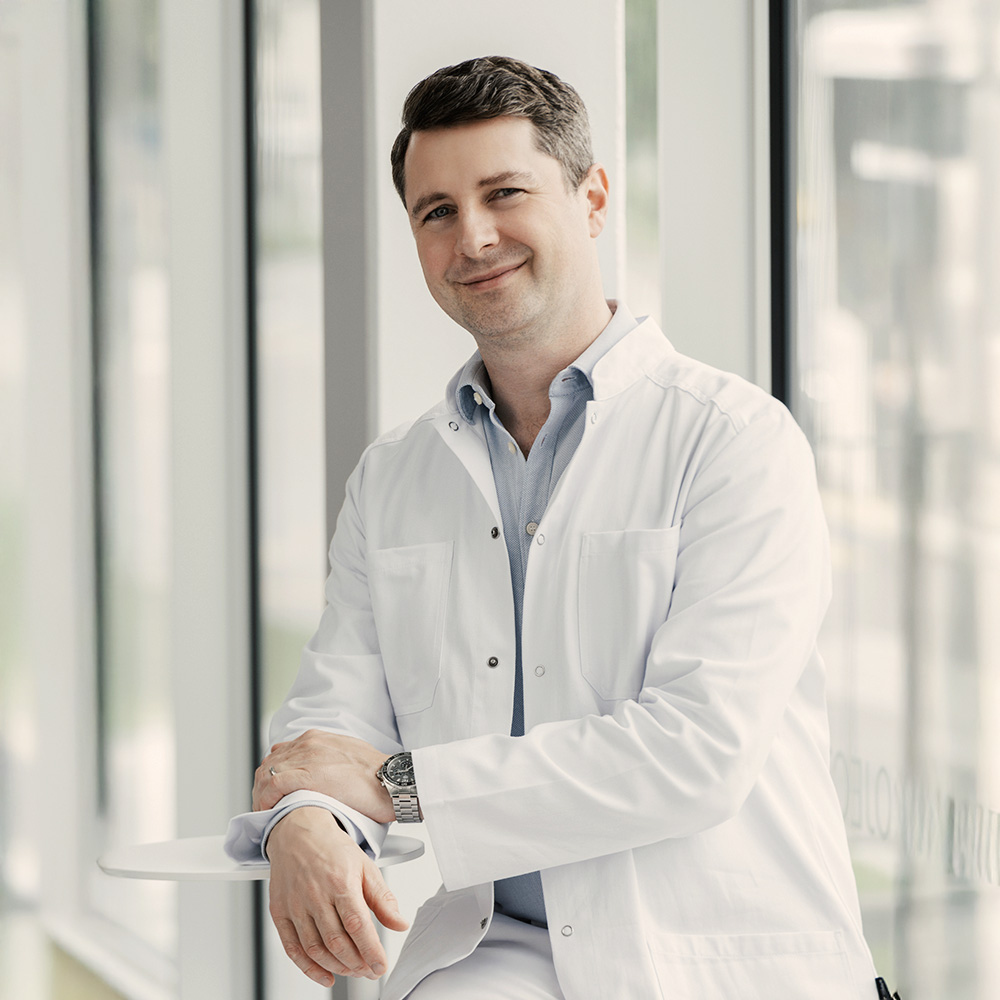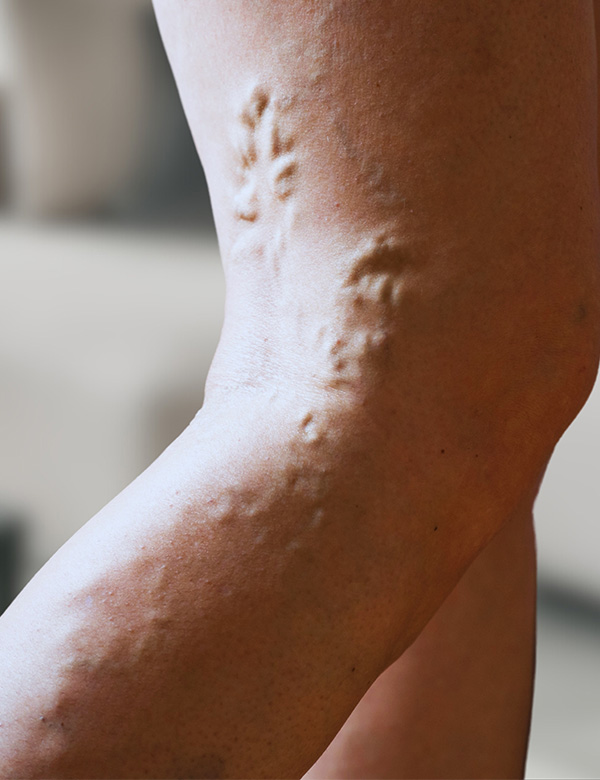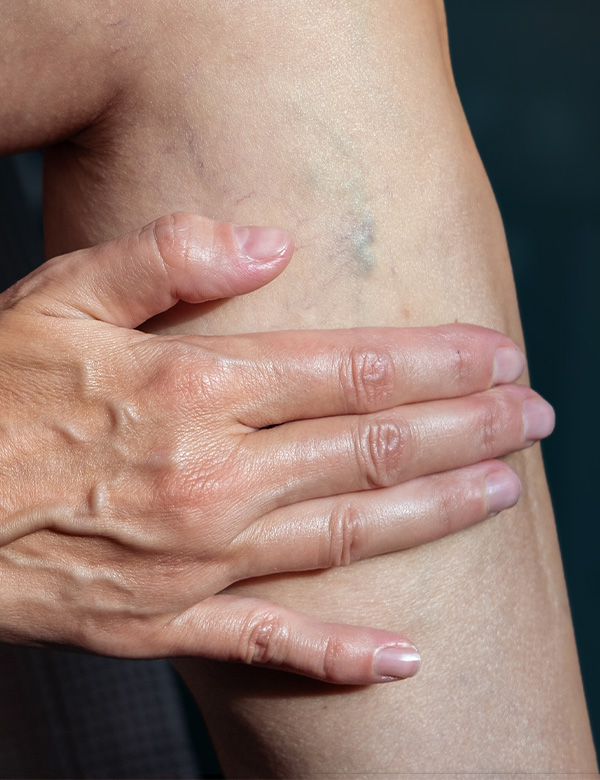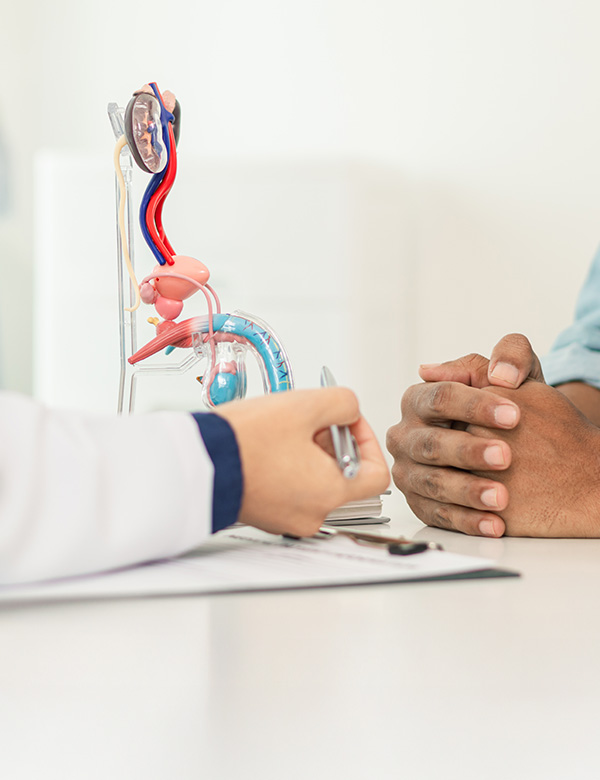Clarify lipedema
Clarify lipedema – Diagnosis and treatment by experienced vascular specialists at the Derma Medical Clinic in Zurich – Sihlcity
Lipedema
Chronische Abszesse und schmerzhafte Knoten durch erfahrenen Hautarzt abklären und behandeln in der Derma Medical Clinic in Zürich - Sihlcity
Painful, swollen legs or arms, a feeling of pressure and tension, or rapidly occurring bruises: Lipedema is a chronic fat distribution disorder that we can reliably recognize and discuss suitable therapy options together.
Examinations
Vascular screening
Ultrasound
Procedure
Initial consultation
Vascular screening
Ultrasound
Duration
approx. 45 minutes
Lipedema at a glance
When is it useful to clarify lipedema?
Lipedema is a chronic fat distribution disorder that affects almost exclusively women.
Typical is a disproportionate increase in legs or arms, while the upper body, hands and feet usually remain slim.
Because the tissue hurts when pressed, the legs swell and bruises appear quickly, it is often mistakenly interpreted as being overweight or as
lymphedema
(water retention),
venous insufficiency
.
These misdiagnoses mean that those affected remain without proper treatment for years.
A targeted diagnosis brings clarity here and opens the way to suitable therapies.
- have permanently painfully swollen legs or arms
- feel a feeling of heaviness or tension in the tissue
- get bruises quickly and without any recognizable cause
- find that the fat distribution is not in proportion to the upper body
- notice that the symptoms started in puberty, pregnancy or menopause or have become stronger
- are unsure whether it is lipedema,
lymphedema
, venous insufficiency
or being overweight (lipohypertrophy) - similar symptoms are already known in the family

When is it useful to clarify lipedema?
Lipedema is a chronic fat distribution disorder that affects almost exclusively women.
Typical is a disproportionate increase in legs or arms, while the upper body, hands and feet usually remain slim.
Because the tissue hurts when pressed, the legs swell and bruises appear quickly, it is often mistakenly interpreted as being overweight or as
lymphedema
(water retention),
venous insufficiency
.
These misdiagnoses mean that those affected remain without proper treatment for years.
A targeted diagnosis brings clarity here and opens the way to suitable therapies.
An examination is recommended if you…
- have permanently painfully swollen legs or arms
- feel a feeling of heaviness or tension in the tissue
- get bruises quickly and without any recognizable cause
- find that the fat distribution is not in proportion to the upper body
- notice that the symptoms started in puberty, pregnancy or menopause or have become stronger
- are unsure whether it is lipedema,
lymphedema
, venous insufficiency
or being overweight (lipohypertrophy) - similar symptoms are already known in the family
Treatment
First, we discuss your symptoms and the development over time, such as whether the problems started in puberty, pregnancy or menopause.
This is followed by a clinical examination: We assess the legs and arms, palpate the tissue and check whether there is pressure pain, nodules or dents in the subcutaneous fatty tissue and whether other clinical signs are present
At the Derma Medical Clinic, our vascular specialist uses a unique screening before every vascular ultrasound: The blood flow in the arms, legs and toes is measured painlessly in just a few minutes using cuffs and small sensors.
Vascular problems such as calcifications or circulatory disorders often appear there first, even before symptoms occur. This allows even early changes to be reliably detected – a diagnostic standard otherwise only offered in specialized vascular centers.
This is followed by an ultrasound, which allows us to additionally display the tissue and vascular structures and thus differentiate lipedema from other diseases.
What Happens after the Examination?
We clarify whether lipedema is present – particularly important in the early stages – and determine the stage and extent of the changes.
At the same time, we differentiate whether it is
lymphedema
,
venous insufficiency
, being overweight (lipohypertrophy) or a mixed form. We then discuss the appropriate therapy options with you: from non-surgical measures to further options such as liposuction.
How does the clarification of lipedema work?
Initial consultation
We talk about your symptoms, the development over time and typical changes in hormonal transition phases.
Examination & ultrasound
We examine legs and arms, check for pressure pain, feeling of tension and tissue structure. With vascular screening and ultrasound, we differentiate lipedema from
lymphedema,
venous insufficiency
or other causes.
Evaluation & Therapy
If lipedema is present, we determine the stage and discuss suitable treatment options. If there is no lipedema, we explain the findings and what further steps make sense.

At the Derma Medical Clinic, vascular diseases are clarified and treated by
Dr. Andreas Gutwein
, specialist in angiology and general internal medicine, FA phlebology
He is a specialist in vascular diseases and has many years of experience in the diagnosis and treatment of lipedema.

Dr. med. Andreas Gutwein
Specialist in Angiology and General Internal Medicine FMH
Expert in Vascular Medicine & Men’s Health

Dr. med. Benjamin Miller
Board-certified Specialist in Dermatology and Venereology FMH
What you can expect from us
Angiology: Vascular medicine
Angiology is the specialist discipline for connective tissue, veins, arteries and lymphatic vessels in medicine. This means that lipedema is not only taken seriously as an “optical problem”, but as a medical condition.
Vascular ultrasound: precise diagnostics
We combine clinical examination with ultrasound and – if useful – other methods to reliably differentiate lipedema from
lymphedema
, venous insufficiency
or being overweight.
Vascular medicine meets dermatology
Many vascular diseases first become noticeable on the skin – through swelling, discoloration, or visible veins. In the Derma Medical Clinic, vascular medicine and dermatology therefore complement each other perfectly.
Everything under one roof
You receive diagnosis, medical treatment, and cosmetic support in one place. This means you have fixed contact persons, short distances, and coordinated care, from the initial examination to aftercare.
Do you suspect lipedema, but have not yet received a clear diagnosis?
Have changes in your arms and legs clarified.
FAQ – Frequently asked questions about lipedema
What is lipedema?
Lipedema is a chronic disorder of fat distribution. Typical are painful, disproportionate fat accumulations, especially on the buttocks, thighs and legs, sometimes also on the arms. They disappear neither through diet nor through sport and often continue to increase over time.
How do I recognize lipedema?
Signs include heavy, pressure-sensitive legs or arms that increase during the day, rapid formation of bruises and a disproportionate fat distribution compared to the upper body.
How is lipedema diagnosed?
The diagnosis is made by a physical examination, often supplemented by ultrasound or other imaging methods. It is important to differentiate and exclude other underlying diseases.
Who makes the diagnosis of lipedema?
In general, angiologists (vascular physicians) are responsible. They can recognize the typical changes and rule out other causes.
Can lipedema be treated with sport or diet?
Sport and weight reduction can alleviate the symptoms, but do not change the diseased fatty tissue. The lipedema itself remains.
What treatment options are available for lipedema?
The proven therapies usually include non-surgical measures, in addition to weight control, especially compression therapy (stockings), lymphatic drainage, exercise and skin care. In severe and rare cases, surgical removal of the fatty tissue may be considered.
What happens if lipedema is left untreated?
The symptoms can increase: pain, restricted movement and a deterioration in the quality of life are possible. The risk of secondary
lymphedema
and
venous insufficiency
also increases.
Can lipedema worsen during pregnancy?
Yes, hormonal changes – such as in puberty, pregnancy or menopause – can increase the severity or make it visible for the first time.
How does lipedema differ from water retention (lymphedema), venous insufficiency or being overweight?
In lipedema, the legs and arms are usually affected on both sides, often with pressure pain and a tendency to bruising.
A
lymphedema
, on the other hand, is more likely to manifest itself through one-sided swelling.
A
venous insufficiency
can be recognized by varicose veins, swelling and a feeling of heaviness in the legs.
Being overweight is distributed evenly over the whole body. With a careful examination and modern diagnostics, we can clearly determine which clinical picture it is or rule it out.



